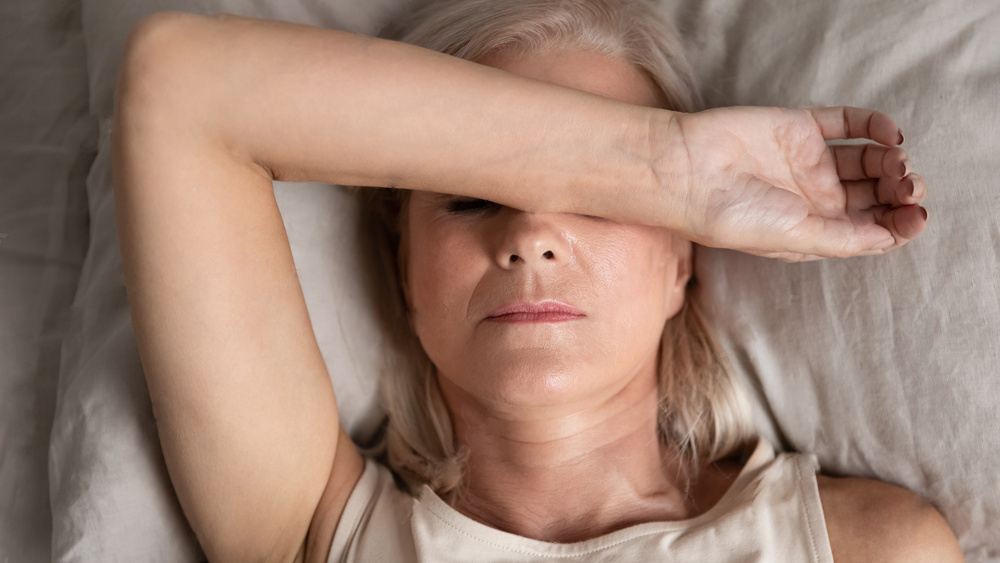Headaches during menopause can incapacitate women who experience them. For instance in the case of migraine headaches, the pain generally comes on slo...
Headaches during menopause can incapacitate women who experience them. For instance in the case of migraine headaches, the pain generally comes on slowly in one side of the head, builds, and begins to pulsate and throb. Women who suffer from headaches of this nature can have difficulty accomplishing the routine tasks of life while in the heat of a painful fit. Fortunately, women don’t have to live with this debilitating yet common symptom of menopause.
Headaches During Menopause
While women may experience headaches in many forms, the experience is never the same for every woman. Types of headaches may vary, but there are basic standards that make them identifiable.
Generally speaking, a migraine headache is a recurrent, throbbing headache generally felt on one side of the head but it may possibly occur on both sides. It can last anywhere from one or two hours up to three days.
Many women entering perimenopause, the 5 to 10 years period leading up to menopause, begin to experience an influx of headaches from a host of factors. In order to distinguish the difference between a normal headache and more serious migraines, continue reading to learn the most common symptoms of migraine headaches.
There are several types of headaches that menopausal women may experience as a result of fluctuating hormone levels.<
What are common symptoms of headaches?
- Throbbing, pulsating pain in the head
- Intensification of pain by routine physical activity
- Pain begins in a specific area on one side of the head
- Pain lasting up to 24 hours or in some cases several
- Nausea and vomiting
- Sensitivity to light, sound and odor
- Sweaty hands and feet
Some women might be familiar with menstrual migraines. These migraines are hormone-related and are sparked on the first day or two of menstruation and recede once menstruation has concluded. Hormonal origins of migraine headaches will be discussed in the causes of headaches section. Other types of migraines include the following:
Migraines with aura
These start with a neurological phenomenon (aura) experienced about half an hour before head pain arrives. Most auras are experienced visually, characterized by bright, shimmering lights around objects or at the edges of the field of vision.
Migraines without aura
This is the most common type of migraine. It can occur on one side or both sides of the head. Fatigue or mood swings may occur 24 hours before the headache. Nausea, vomiting, and sensitivity to light (photophobia) often accompany migraines without aura.
Tension headaches
Theseare the most common type of headache, affecting 64% of men and 88% of women at least some time during their lifetimes. A tension headache generally produces a diffuse, usually mild to moderate pain throughout the head. The feeling has been likened to that of having a tight band synched around the head. A tension headache may also cause pain in the back of your neck at the base of your skull.
The third most frequently experienced type of headache for menopausal women is a sinus headache. To understand sinus headaches, it’s best to first start by defining what sinuses are. Sinuses are air-filled cavities located in the cheekbones, forehead, and behind the bridge of the nose. The sinuses produce thin mucus that drains out of the channels of the nose. When a sinus becomes inflamed, usually as the result of an allergic reaction or an infection, the inflammation will prevent the outflow of mucus
and cause a pain similar to that of a headache.
A sinus headache, then, is the inflammation and blockage of the sinus cavities. This is also known as congestion or a congestion headache.
What Causes Headaches During Menopause?
Any woman who has found herself incapacitated with headache pain every time her period rolls around has probably already discovered the connection between headaches and hormones, which wax and wane during menstruation. Similarly, hormonal levels fluctuation, wildly experienced by women as they approach menopause, can spark painful migraine headaches.
As menopause approaches, women’s oestrogen and progesterone levels surge and dip prior to the levels receding to a low level once she passes through menopause and is no longer menstrual. This oestrogen imbalance is known to affect the brain in various ways, including the onset of headaches.
Types of headache sufferers
There are two types of women who suffer from hormone related headaches: women whose headaches are caused by declining oestrogen hormones, and women whose headaches are caused by elevated oestrogen levels. Dramatically fluctuating oestrogen levels just before menopause can cause both types of headaches. Many doctors believe that a long duration of significantly increased levels of oestrogen, followed by a sudden drop in hormones, such as the time just before menopause, will cause more severe headaches than even menstrual headaches.
Research attempting to discover exactly why hormonal fluctuations cause headaches during menopause is still inconclusive. However, most doctors agree that the reason has to do with the effects that hormones, such as oestrogen and progesterone, have on the brain and its blood vessels. Oestrogen causes blood vessels to dilate, while progesterone causes them to constrict. As the hormones fluctuate, the blood vessels are forced to expand and contract, resulting in intense pain in the head. Read below for additional causes of headaches during menopause.
Other causes and triggers of headaches
Although hormonal imbalance is the primary cause of headaches for women going through menopause, there are other factors that can either trigger or exacerbate headaches.
Below there is a list of triggers that can set off headaches.
- Bright lights, loud noises, or strong odors
- Stress, anxiety, or relaxation after stress
- Weather changes
- Alcohol, caffeine (too much or withdrawal)
- Lack of or too much sleep
- Skipped meals or fasting
About The Author - AMC Team
Our team consists of doctors, nurses, program assistants, naturopaths and nutritionists that join their wealth of knowledge to offer our patients and website visitors interesting and insightful articles to assist you understand the symptoms you are experiencing and how to relieve them.

